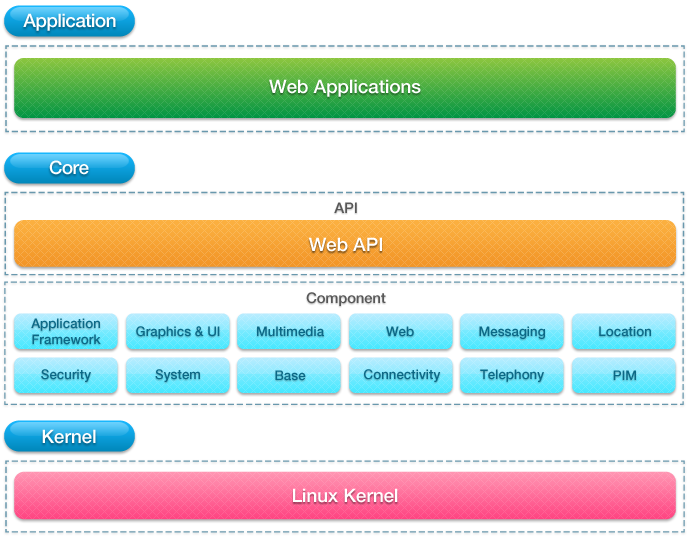Tizen Architecture
Tizen provides a standards-based software platform for multiple device categories. The current software, described below, is targeted towards smartphones and tablet devices - additional device targets will be defined soon. The software platform supports web applications. The Tizen Web API reference provides a comprehensive description for Web application development.
The figure below illustrates the Tizen architecture for smartphone and tablet devices. It consists of three layers: application, core, and kernel.

The Application Layer
Tizen supports Web applications. Tizen Web applications leverage the full power of the platform, just like native applications.
The Core Layer
The Core layer consists of Tizen API and Tizen Core Service.
Tizen API Layer
Tizen Web applications can be developed using the Tizen Web API. The Tizen Web API is a collection of W3C (HTML5 and more), Khronos WebGL, and newly defined device APIs.
Tizen Core Service
Application Framework
The Application Framework provides application management, including launching other applications using the package name, URI, or MIME type. It also launches pre-defined services, such as the system dialer application.
The Application Framework also notifies applications of common events, such as low memory events, low battery, changes in screen orientation, and push notification.
Base
Base contains Linux base essential system libraries that provide key features, such as database support, internationalization, and XML parsing.
Connectivity
Connectivity consists of all network- and connectivity-related functionalities, such as 3G, Wi-Fi, Bluetooth, HTTP, and NFC (Near Field Communication).
Data network is based on ConnMan (Connection Manager), which provides 3G and Wi-Fi based network connection management.
Graphics and UI
Graphics and UI consist of the system graphic and UI stacks, which includes EFL (Enlightenment Foundation Libraries), an X11-based window management system, input methods, and OpenGL ES.
EFL, the heart of the Graphics component, is a suite of libraries. EFL is used to create rich graphics with ease, for all UI resolutions. The libraries build UIs in layers, allowing for 3D transformations and more. EFL includes the Evas canvas API library and the elementary widget library.
Location
Location provides location based services (LBS), including position information, geocoding, satellite information, and GPS status. It is based on GeoClue, which delivers location information from various positioning sources such as GPS, WPS (Wi-Fi Positioning System), Cell ID, and sensors.
Messaging
Messaging consists of SMS, MMS, Email, and IM.
Multimedia
Multimedia is based on GStreamer. It provides support for media, including video, audio, imaging, and VoIP. It also provides media content management for managing media file metadata information.
PIM (Personal Information Management)
PIM enables managing user data on the device, including managing calendar, contacts, tasks, and retrieving data about the device context (such as device position, cable status).
Security
Security is responsible for security deployment across the system. It consists of platform security enablers, such as access control, certificate management, and secure application distribution.
System
System consists of system and device management features, including:
- Interfaces for accessing devices, such as sensors, display, or vibrator.
- Power management, such as LCD display backlight dimming/off and application processor sleep.
- Monitoring devices and handling events, such as USB, MMC, charger, and ear jack events.
- System upgrade.
- Mobile device management.
Telephony
Telephony consists of cellular functionalities communicating with the modem:
- Managing call-related and non-call-related information and services for UMTS and CDMA.
- Managing packet service and network status information for UMTS and CDMA.
- Managing SMS-related services for UMTS and CDMA.
- Managing SIM files, phone book, and security.
- Managing SIM Application Toolkit services for UMTS.
Web
Web provides a complete implementation of the Tizen Web API optimized for low power devices. It includes WebKit, which is a layout engine designed to allow web browsers to render web pages. It also provides web runtimes for web applications.
Kernel Layer
The kernel layer includes the Linux Kernel and device drivers.
